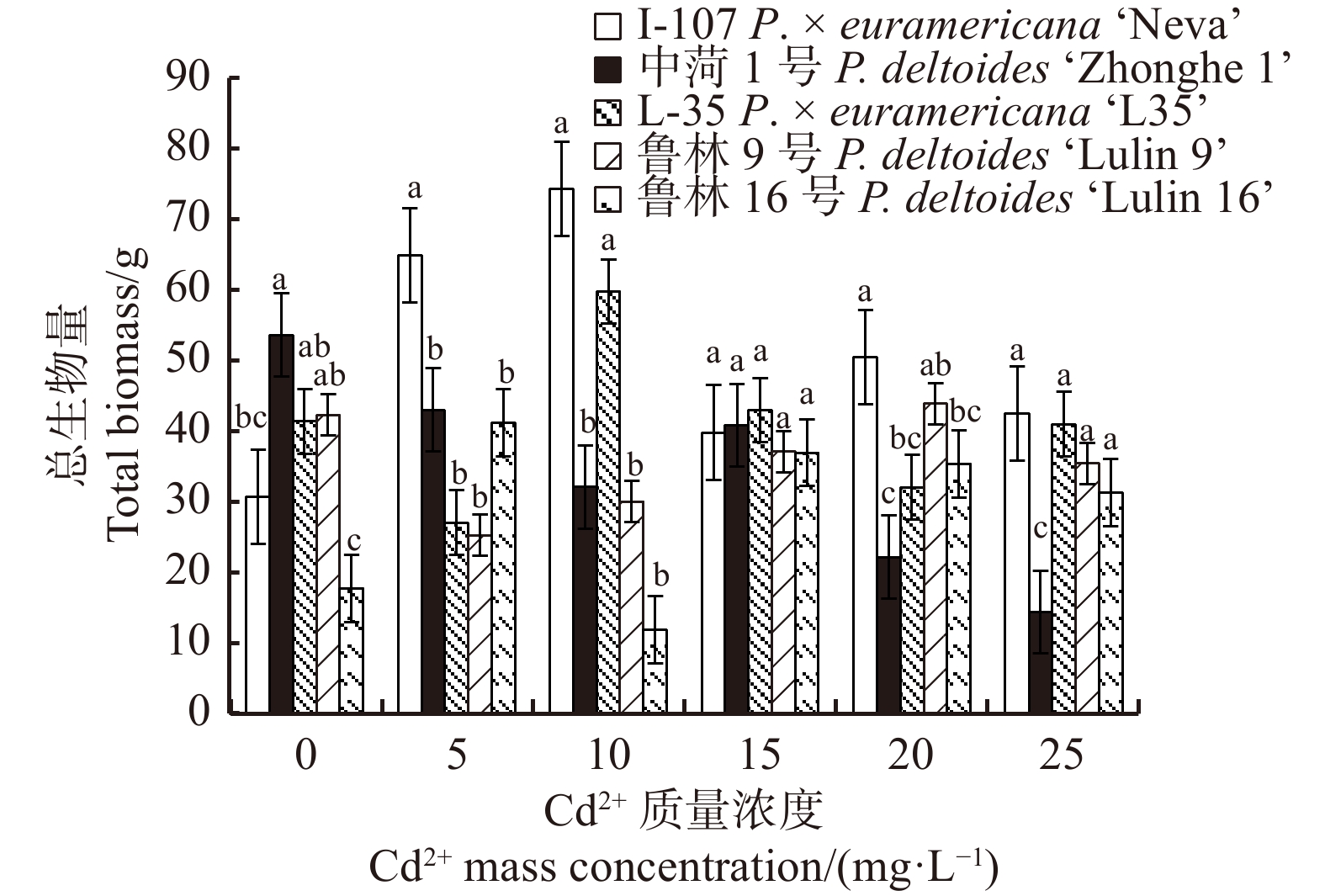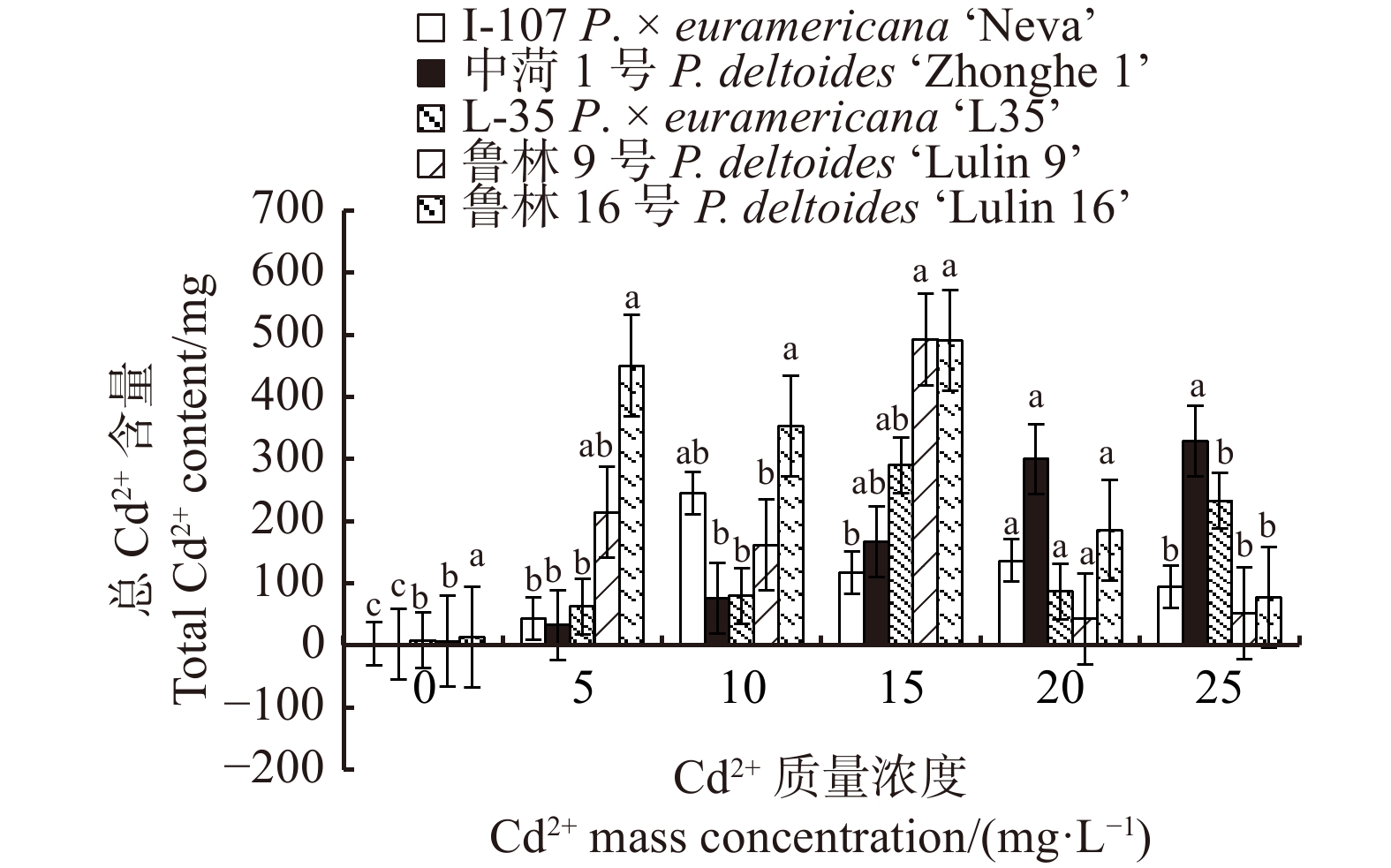Effects of cadmium stress on biomass and cadmium ion content of Sect. Aigeiros clones
-
摘要:目的 研究重金属镉(Cd)对黑杨派无性系生物量及镉离子含量的影响,探讨无性系对Cd胁迫的响应机制,为治理日渐严重的土壤重金属污染治理提供依据。方法 对黑杨派的5个无性系进行沙培试验,分别测定其生长量、不同器官生物量及Cd2+ 含量,评价不同无性系抗Cd胁迫的能力。结果 随着Cd2+ 质量浓度增加,胁迫后苗高与地径均呈下降趋势,各无性系苗高性状较地径对Cd胁迫更为敏感;胁迫后叶片数量整体呈下降趋势。通过对不同无性系叶片生物量均值分析发现,无性系I-107、L-35、中菏1号排在前3位,除15 mg/L Cd2+ 质量浓度外,在其他质量浓度胁迫下差异均达显著水平。随着Cd2+ 质量浓度增加,不同无性系茎生物量与根生物量变化趋势一致,整体先降低,后升高再降低。对不同质量浓度Cd2+ 胁迫下茎与根生物量的均值进行分析,发现无性系I-107、鲁林9号、L-35的茎生物量排在前3位,I-107、鲁林16号、L-35的根生物量排在前3位。各无性系茎中Cd2+ 含量随Cd2+ 质量浓度的增加均有不同程度升高,其中无性系I-107较对照增长率最大,其次为鲁林9号。在最高质量浓度胁迫下,鲁林9号的茎中Cd2+ 含量较其他无性系差异达显著水平。不同无性系叶片和根中Cd2+ 含量随质量浓度增加均有不同程度升高,在最高质量浓度胁迫下,无性系I-107、中菏1号、鲁林9号中叶片Cd2+ 含量较对照增长率排在前3位。无性系中菏1号、I-107、L-35中根Cd2+ 含量较对照增长率排在前3位。总生物量呈先升高再降低的趋势,总Cd2+ 含量呈先升高再降低再升高的趋势。结论 利用主成分分析对5个无性系生长量、生物量及Cd2+ 含量进行综合评价,发现无性系I-107、鲁林9号和L-35的抗重金属Cd能力较强,可为重金属Cd污染土壤的治理与修复提供试验材料。Abstract:Objective In order to study the effects of heavy metal stress on biomass and cadmiumion content of Sect. Aigeiros clones, the response mechanism of clones to Cd stress was discussed, which provided a theoretical basis for the increasingly serious soil heavy metal pollution problem.Method Sand culture experiments were carried out on five Sect. Aigeiros clones, growth, biomass and cadmium content of different organs were measured to evaluate the resistance of different clones to Cd stress.Result With the increase of Cd2+ mass concentration, the seedling height and ground diameter decreased under Cd stress, the height traits of tested clones were more sensitive to Cd stress than the ground diameter; the number of leaves decreased after Cd stress. Based on the analysis of the mean value of leaf biomass of different clones, it was found that clones ‘I-107’ , ‘L-35’ and ‘Zhonghe 1’ were in the top three, except for the mass concentration of Cd2+ being 15mg/L, the difference was significant under other mass concentrations. With the increase of Cd2+ mass concentration, the variation trend of stem biomass and root biomass of different clones was the same, the whole trend was first decreased, then increased and then decreased. The average of stem and root biomass under different mass concentrations of Cd stress were analyzed, the stem biomass of ‘I-107’ , ‘Lulin 9’ and ‘L-35’ were in the top three, and the root biomass of ‘ I-107’, ‘Lulin 16’ and ‘L-35’ were in the top three. The Cd content in stems of different clones increased with the increase of Cd2+ mass concentration, and ‘I-107’had the highest growth rate compared with the control, followed by ‘Lulin 9’. Under the highest mass concentration, the difference between ‘Lulin 9’and other clones was significant. The Cd content in leaves and roots of different clones increased with the increase of Cd2+ mass concentration. Under the highest mass concentration, the content of Cd2+ in the leaves of ‘I-107’ , ‘Zhonghe 1’ and ‘Lulin 9’ was in the top three compared with the growth rate of the control; and the content of Cd2+ in roots of ‘Zhonghe 1’,‘I-107’and ‘L-35’ was in the top three compared with the growth rate of control. The total biomass increased first and then decreased; the total Cd content increased first, then decreased and then increased.Conclusion The growth, biomass and Cd content of five clones were comprehensively evaluated by principal component analysis, ‘I-107’ ,‘Lulin 9’ and ‘L-35’ had strong resistance to Cd, which could be used as ideal clones for remediation of cadmium-contaminated soils.
-
Keywords:
- cadmium stress /
- Sect. Aigeiros /
- clone /
- biomass /
- cadmium ion content
-
-
图 1 不同Cd2+质量浓度对不同无性系苗高的影响
不同小写字母表示同一处理不同无性系间差异显著(P < 0.05)。下同。Different lowercase letters indicate that there are significant differences among varied clones in the same treatment (P < 0.05). The same below.
Figure 1. Effects of Cd2+ with different mass concentrationson seedling heigh of varied clones
表 1 黑杨派无性系Cd胁迫下的主成分分析
Table 1 Principal component analysis on Aigeiros clones under Cd stress
测定指标
Measurement index第1主成分
Principal component 1第2主成分
Principal component 2第3主成分
Principal component 3第4主成分
Principal component 4特征根 Characteristic root 5.253 7 2.573 9 1.853 4 1.319 1 贡献率 Contribution rate/% 47.76 23.40 16.85 11.99 累计贡献率 Cumulative contribution rate/% 47.76 71.16 88.01 100.00 苗高 Seedling height 0.419 8 0.078 0 0.010 1 0.210 3 地径 Ground diameter 0.158 2 0.311 2 −0.402 9 0.491 4 叶片数 Leaf number 0.272 3 0.208 6 0.451 6 0.302 5 叶片生物量 Leaf biomass 0.331 5 −0.122 0 0.432 6 −0.169 0 茎生物量 Stem biomass 0.384 6 0.184 0 −0.118 2 −0.288 4 根生物量 Root biomass 0.061 8 −0.428 5 0.043 2 0.618 0 茎Cd2+含量 Cd2+ content of stem −0.062 0 −0.584 1 −0.164 3 −0.197 7 叶片Cd2+含量 Cd2+ content of leaf 0.268 9 0.240 4 −0.470 0 −0.216 7 根Cd2+含量 Cd2+ content of root −0.342 9 0.332 9 0.228 8 −0.009 4 总生物量 Total biomass 0.388 7 −0.039 8 0.280 2 −0.207 3 总Cd2+含量 Total Cd2+ content −0.343 8 0.331 3 0.227 9 −0.010 9 表 2 5个无性系的主成分值及其排序
Table 2 Principal component values and ranking of 5 Aigeiros clones
无性系
CloneI-107
P. × euramericana
‘Neva’中菏1号
P. deltoides
‘Zhonghe 1’L-35
P. × euramericana
‘L-35’鲁林9号
P. deltoides
‘Lulin 9’鲁林16号
P. deltoides
‘Lulin 16’主成分值 Principal component value 2.253 6 −3.444 8 0.103 3 1.860 6 −0.772 7 排序 Order 1 5 3 2 4 -
[1] Hu H, Jin Q, Kavan P. A study of heavy metal pollution in China: current status, pollution-control policies and countermeasures[J]. Sustainability, 2014, 6(9): 5820−5838. doi: 10.3390/su6095820
[2] Ponsbranchu E, Ayrault S, Roybarman M, et al. Three centuries of heavy metal pollution in Paris (France) recorded by urban speleothems[J]. Science of the Total Environment, 2015, 518–519: 86−96.
[3] 杨海琳. 土壤重金属污染修复的研究[J]. 环境科学与管理, 2009, 34(6):130−135. doi: 10.3969/j.issn.1673-1212.2009.06.038 Yang H L. Remediation of heavy metal polluted soil[J]. Environmental Science and Management, 2009, 34(6): 130−135. doi: 10.3969/j.issn.1673-1212.2009.06.038
[4] 吴双桃. 镉污染土壤治理的研究进展[J]. 广东化工, 2005(4):40−41, 50. doi: 10.3969/j.issn.1007-1865.2005.04.015 Wu S T. The latest development about the remedy of Cd contaminated soil[J]. Guangdong Chemical Industry, 2005(4): 40−41, 50. doi: 10.3969/j.issn.1007-1865.2005.04.015
[5] 王娜, 魏样. 土壤重金属镉污染来源及其修复技术探究[J]. 环境与发展, 2019, 31(8):55−56, 58. Wang N, Wei Y. Study on sources of heavy metal cadmium pollution in soil and its remediation technology[J]. Environment and Development, 2019, 31(8):55−56, 58.
[6] 周东美, 邓昌芬. 重金属污染土壤的电动修复技术研究进展[J]. 农业环境科学学报, 2003, 22(4):505−508. doi: 10.3321/j.issn:1672-2043.2003.04.031 Zhou D M, Deng C F. Electrokinetic remediation of heavy metal contaminated soil[J]. Journal of Agro-Environment and Science, 2003, 22(4): 505−508. doi: 10.3321/j.issn:1672-2043.2003.04.031
[7] 樊霆, 叶文玲, 陈海燕等. 农田土壤重金属污染状况及修复技术研究[J]. 生态环境, 2013, 22(10):1727−1736. Fan T, Ye W L, Cheng H Y, et al. Review on contamination and remediation technology of heavy metal in agricultural soil[J]. Ecology and Environmental Sciences, 2013, 22(10): 1727−1736.
[8] Lau R I, Blust R, Temmerman L D, et al. Clonal variation in heavy metal accumulation and biomass production in a poplar coppice culture(I): seasonal variation in leaf, wood and bark concentrations[J]. Environmental Pollution, 2004, 131(3): 485−494. doi: 10.1016/j.envpol.2004.02.009
[9] Mihucz V G, Csog A, Fodor F, et al. Impact of two iron( III) chelators on the iron, cadmium, lead and nickel accumulation in poplar grown under heavy metal stress in hydroponics[J]. Journal of Plant Physiology, 2012, 169(6): 561−566. doi: 10.1016/j.jplph.2011.12.012
[10] Elobeid M, Gobel C, Feussne R I, et al. Cadmium interferes with auxin physiology and lignification in poplar[J]. Journal of Experimental Botany, 2012, 63(3): 1413−1421. doi: 10.1093/jxb/err384
[11] 姜岳忠, 李善文, 秦光华, 等. 黑杨派无性系区域化试验初报[J]. 林业科学, 2006, 42(12):143−147. doi: 10.3321/j.issn:1001-7488.2006.12.026 Jiang Y Z, Li S W, Qin G H, et al. Regional test of poplar clones in section Aigeiros[J]. Scientia Silvae Sinicae, 2006, 42(12): 143−147. doi: 10.3321/j.issn:1001-7488.2006.12.026
[12] 杨园, 王艮梅. 杨树对镉胁迫的响应及抗性机制研究进展[J]. 世界林业研究, 2017, 30(4):29−34. Yang Y, Wang G M. Poplar response to Cd stress and its resistance mechanism[J]. World Forestry Research, 2017, 30(4): 29−34.
[13] 姚俊修, 乔艳辉, 杨庆山, 等. 重金属镉胁迫对黑杨派无性系光合生理及生长的影响[J]. 西北林学院学报, 2020, 35(2):40−46. Yao J X, Qiao Y H, Yang Q S, et al. Effects of cadmium stress on growth and photosynthesis of Aigeiros clones[J]. Journal of Northwest Forestry University, 2020, 35(2): 40−46.
[14] Ahmed S. 镉胁迫下 3 种杨树种间生理响应及植物修复潜力[D]. 绵阳: 西南科技大学, 2018. Ahmed S. Inter-species physiological response and phytoremediation potential of three poplar species under cadmium stress [D]. Mianyang: Southwest University of Science and Technology, 2018.
[15] 杨传宝, 孙超, 李善文, 等. 白杨派无性系苗期耐盐性综合评价及筛选[J]. 北京林业大学学报, 2017, 39(10):24−32. Yang C B, Sun C, Li S W, et al. Comprehensive evaluation and screening of salt tolerance for Leuce clones at nursery stage[J]. Journal of Beijing Forestry University, 2017, 39(10): 24−32.
[16] 杨传宝, 倪惠菁, 李善文, 等. 白杨派无性系苗期对NaHCO3胁迫的生长生理响应及耐盐碱性综合评价[J]. 植物生理学报, 2016, 52(10):1555−1564. Yang C B, Ni H J, Li S W, et al. Growth and physiological responses to NaHCO3 stress and comprehensive evaluation on saline-alkaline tolerance in Leuce clones at seedling stage[J]. Plant Physiology Journal, 2016, 52(10): 1555−1564.
[17] 杨传宝, 姚俊修, 李善文, 等. 白杨派无性系苗期对干旱胁迫的生长生理响应及抗旱性综合评价[J]. 北京林业大学学报, 2016, 38(5):58−66. Yang C B, Yao J X, Li S W, et al. Growth and physiological responses to drought stress and comprehensive evaluation on drought tolerance in Leuce clones at nursery stage[J]. Journal of Beijing Forestry University, 2016, 38(5): 58−66.
[18] 姚俊修, 陈甘牛, 李善文, 等. 镉胁迫对黑杨派无性系生理生化特性及生长的影响[J]. 北京林业大学学报, 2020, 42(4):12−20. doi: 10.12171/j.1000-1522.20190462 Yao J X, Chen G N, Li S W, et al. Physiological and biochemical properties and growth of Aigeiros clones under cadmium stress[J]. Journal of Beijing Forestry University, 2020, 42(4): 12−20. doi: 10.12171/j.1000-1522.20190462
[19] 马文进. 石墨炉原子吸收光谱法测定土壤中铅和镉[J]. 环境与发展, 2017(5):199−200. Ma W J. Graphite furnace atomic absorption spectrometry determination of lead and cadmium in soil[J]. Environment and Development, 2017(5): 199−200.
[20] 马建宏, 李阳. 石墨炉原子吸收光谱法测定土壤中重金属铅、镉的方法改进[J]. 理化试验(化学分册), 2020, 56:94−96. Ma J H, Li Y. Improvement on the determination of lead and cadmium in soil by graphite furnace atomic absorption spectrometry[J]. Physical and chemical test (Chemistry Division), 2020, 56: 94−96.
[21] 顾颉刚. 镉胁迫对杨树无性系植株生长发育及部分生理特性影响的研究[D]. 天津: 天津师范大学, 2008. Gu J G. The study on Cd effect of growth and some physiological charaeteristics of Populus clone[D]. Tianjin: Tianjin Normal University, 2008.
[22] 邓惠强, 聂呈荣. 不同改良剂对镉污染土壤中油麦菜生物量及镉含量的影响[J]. 佛山科学技术学院学报, 2013, 31(4):6−11. Deng H Q, Nie C R. Effects of different soil amelioration materials on the growth and Cd contents of Lactuca sativa L. in Cd contaminated soil[J]. Journal of Foshan University, 2013, 31(4): 6−11.
[23] 汪翔, 赵玲. 赤泥对水稻植株各部位镉含量及水稻生物量的影响[J]. 现代科学仪器, 2010(4):105−109. Wang X, Zhao L. Effect of red mud on the cadmium content in different parts of rice and rice biomass[J]. Modern Scientific Instruments, 2010(4): 105−109.
[24] 龙聪颖, 邓辉茗, 苏明洁, 等. 镉和模拟酸雨胁迫对苦楝幼苗镉含量及叶片抗氧化系统的影响[J]. 核农学报, 2020, 34(1):186−194. doi: 10.11869/j.issn.100-8551.2020.01.0186 Long C Y, Deng H M, Su M J, et al. Effects of simulated acid rain and cadmium stress on Cd content and antioxidant system of Melia azedarach L. seedlings[J]. Journal of Nuclear Agricultural Sciences, 2020, 34(1): 186−194. doi: 10.11869/j.issn.100-8551.2020.01.0186
[25] 谭长强, 何琴飞, 秦玉燕, 等. 施氮对镉胁迫下杂交相思树生长及镉吸收分配的影响[J]. 植物营养与肥料学报, 2017, 23(5):1326−1334. doi: 10.11674/zwyf.17011 Tan Z Q, He Q F, Qin Y Y, et al. Effect of nitrogen application on seedling growth and cadminm uptake and distribution in Acacia mangium × Acacia auriculiformis under cadmium stress[J]. Journal of Plant Nutrition and Fertilizer, 2017, 23(5): 1326−1334. doi: 10.11674/zwyf.17011
[26] 薛晨阳. 镉胁迫下瘤突苍耳和苍耳的生长与富集特征[D]. 沈阳: 沈阳农业大学, 2019. Xue C Y. Growth and accumulation characteristics of Xanthium strumarium and Xanthium sibiricum under cadmium stress [D]. Shenyang: Shenyang Agricultural University, 2019.
[27] Jeelani N, Yang W, Qiao Y, et al. Individual and combined effects of cadmium and polycyclic aromatic hydrocarbons on the phytoremediation potential of Xanthium sibiricum in co-contaminated soil[J]. International Journal of Phytoremediations, 2018, 20(8): 773−779. doi: 10.1080/15226514.2018.1425666
-
期刊类型引用(11)
1. 赵熙来,周正,葛锐,罗伟豪,马旭彤,蒋慧,苏华维. 残次香梨与乳酸菌组合对四翅滨藜青贮的影响. 中国饲料. 2024(17): 155-161 .  百度学术
百度学术
2. 张衡锋,杨绮,韦庆翠,张焕朝. 盐胁迫对10个品种紫薇的影响及其耐盐性综合评价. 东北林业大学学报. 2023(09): 34-40 .  百度学术
百度学术
3. 李雨欣,罗秀丽,张婷婷,康宇乾,王鹏,江行玉,周扬. 盐胁迫下海马齿生理指标变化及相关基因表达分析. 农业生物技术学报. 2022(07): 1279-1289 .  百度学术
百度学术
4. 刘鹤莹,张嫚,翟中葳,杨鹏,支苏丽,沈仕洲,张克强. 大薸对奶厅废水主要污染物的去除效果研究. 农业环境科学学报. 2022(11): 2525-2538 .  百度学术
百度学术
5. 王涛,蒙仲举,张佳鹏,雷虹娟,张格. NaCl胁迫对紫穗槐幼苗生长及生理特性的影响. 西北林学院学报. 2021(01): 25-30 .  百度学术
百度学术
6. 刘学良,姚俊修,刘翠兰,李善文,任飞,李庆华,吴海涛,翟红莲,吴德军,邢世岩,高红萍. 7个接骨木无性系苗木对盐胁迫的生理响应与评价. 中南林业科技大学学报. 2021(01): 37-44+79 .  百度学术
百度学术
7. 鲁俊倩,武舒,钟姗辰,张伟溪,苏晓华,张冰玉. ‘84K’杨组氨酸激酶基因PaHK3a的表达及功能分析. 北京林业大学学报. 2021(02): 46-53 .  本站查看
本站查看
8. 丁丁,王红宝,郑伶杰,左永梅,韩民利,吴新海,郭艳超. 不同品种茶菊对NaCl胁迫的生理响应及耐盐性评价. 植物生理学报. 2021(03): 692-702 .  百度学术
百度学术
9. 赵佳伟,李清亚,路斌,李艳,朱玉菲,栗浩,路丙社. 不同品种北美豆梨对NaCl胁迫的生理响应及耐盐性评价. 植物生理学报. 2019(01): 23-31 .  百度学术
百度学术
10. 邹晓君,列志旸,薛立. NaCl胁迫对4种园林植物养分含量和贮量的影响. 华南农业大学学报. 2018(06): 77-84 .  百度学术
百度学术
11. 杨传宝,孙超,李善文,姚俊修,刘敬国,矫兴杰. 白杨派无性系苗期耐盐性综合评价及筛选. 北京林业大学学报. 2017(10): 24-32 .  本站查看
本站查看
其他类型引用(5)




 下载:
下载:










